Potential of Particle Matter Dry Deposition on Green Roofs and Living Walls Vegetation for Mitigating Urban Atmospheric Pollution in Semiarid Climates
Abstract
:1. Introduction
2. Materials and Methods
2.1. Selected Plant Species
2.2. Experimental Site and Setup
2.3. Experimental Method to Quantify the Dry Deposition of PM
2.4. Quantification of PM Dry Deposition
3. Results and Analysis
3.1. Dry Deposition of PM of GR and LW Species
3.2. Effects of Vegetation on PM Concentration
3.3. Other Performance Aspects to Be Considered
4. Conclusions
- -
- Vegetation of GRs and LWs can significantly reduce the peak and concentrations of PM2.5 and PM10. S. album and S. reflexum reduced PM2.5 peak concentration up to 45.3% and 71.4% of the peak concentrations with no vegetation, respectively. Similar results were found for PM10.
- -
- Statistically significant differences of PM dry deposition were found among the GR and LW vegetation species studied. Three distinctive groups of species with high, medium, and low potential to remove PM2.5, PM10, and PM in leaf wax were identified. S. album showed the highest total PM dry deposition (29.3 ± 8.7 µg·cm−2·h−1) while the lowest values were found for L. angustifolia, E. karvinskianus, and P. tobira.
- -
- It was consistently found that species show high, medium, or low dry deposition values for PM2.5, PM10, and wax. These is important because the ability of species to remove PM is not dependent of the PM size and the way (dry deposition on the leaves vs captured by leaf wax) how PM is removed from the environment. This fact simplifies the decision of policy-makers and designers about the species that can have higher impact on reducing urban air pollution.
Author Contributions
Funding
Acknowledgments
Conflicts of Interest
References
- MMA. Informe del Estado del Medio Ambiente 2011; Ministerio del Medio Ambiente: Santiago, Chile, 2012; p. 513.
- Diaz-Robles, L.A.; Fu, J.S.; Vergara-Fernandez, A.; Etcharren, P.; Schiappacasse, L.N.; Reed, G.D.; Silva, M.P. Health risks caused by short term exposure to ultrafine particles generated by residential wood combustion: A case study of Temuco, Chile. Environ. Int. 2014, 66, 174–181. [Google Scholar] [CrossRef] [PubMed]
- Pope, C.A.; Dockery, D.W.; Chow, J.C.; Watson, J.G.; Mauderly, J.L.; Costa, D.L.; Wyzga, R.E.; Vedal, S.; Hidy, G.M.; Altshuler, S.L.; et al. Health effects of fine particulate air pollution lines that connect. J. Air Waste Manag. Assoc. (1995) 2006, 56, 1368–1380. [Google Scholar] [CrossRef]
- Gulsrud, N.M.; Hertzog, K.; Shears, I. Innovative urban forestry governance in Melbourne?: Investigating “green placemaking” as a nature-based solution. Environ. Res. 2018, 161, 158–167. [Google Scholar] [CrossRef] [PubMed]
- Weyens, N.; Thijs, S.; Popek, R.; Witters, N.; Przybysz, A.; Espenshade, J.; Gawronska, H.; Vangronsveld, J.; Gawronski, S.W. The Role of Plant-Microbe Interactions and Their Exploitation for Phytoremediation of Air Pollutants. Int. J. Mol. Sci. 2015, 16, 25576–25604. [Google Scholar] [CrossRef] [PubMed]
- Song, Y.; Maher, B.A.; Li, F.; Wang, X.; Sun, X.; Zhang, H. Particulate matter deposited on leaf of five evergreen species in Beijing, China: Source identification and size distribution. Atmos. Environ. 2015, 105, 53–60. [Google Scholar] [CrossRef] [Green Version]
- Ottelé, M.; van Bohemen, H.D.; Fraaij, A.L.A. Quantifying the deposition of particulate matter on climber vegetation on living walls. Ecol. Eng. 2010, 36, 154–162. [Google Scholar] [CrossRef]
- Chen, L.; Liu, C.; Zou, R.; Yang, M.; Zhang, Z. Experimental examination of effectiveness of vegetation as bio-filter of particulate matters in the urban environment. Environ. Pollut. 2016, 208, 198–208. [Google Scholar] [CrossRef] [PubMed]
- Muñoz, D.; Aguilar, B.; Fuentealba, R.; Préndez, M. Environmental studies in two communes of Santiago de Chile by the analysis of magnetic properties of particulate matter deposited on leaves of roadside trees. Atmos. Environ. 2017, 152, 617–627. [Google Scholar] [CrossRef]
- Przybysz, A.; Saebo, A.; Hanslin, H.M.; Gawronski, S.W. Accumulation of particulate matter and trace elements on vegetation as affected by pollution level, rainfall and the passage of time. Sci. Total Environ. 2014, 481, 360–369. [Google Scholar] [CrossRef] [PubMed]
- Dzierzanowski, K.; Popek, R.; Gawronska, H.; Saebo, A.; Gawronski, S.W. Deposition of particulate matter of different size fractions on leaf surfaces and in waxes of urban forest species. Int. J. Phytoremediat. 2011, 13, 1037–1046. [Google Scholar] [CrossRef] [PubMed]
- Speak, A.F.; Rothwell, J.J.; Lindley, S.J.; Smith, C.L. Urban particulate pollution reduction by four species of green roof vegetation in a UK city. Atmos. Environ. 2012, 61, 283–293. [Google Scholar] [CrossRef]
- Papaioannou, I. Vegetated Facades as Environmental Control Systems Filtering Fine Particulate Matter (PM2.5) for Improving Indoor Air Quality; University of Southern California: Los Angeles, CA, USA, 2013. [Google Scholar]
- Stapleton, E.; Ruiz-Rudolph, P. The potential for indoor ultrafine particle reduction using vegetation under laboratory conditions. Indoor Built Environ. 2016, 27, 70–83. [Google Scholar] [CrossRef]
- Tan, P.T.; Sia, A. A Pilot Green Roof Research Project in Singapore. In Third Annual Greening Rooftops for Sustainable Communities Conference; Green Roofs for Healthy Cities: Toronto, ON, Canada, 2005; p. 9. [Google Scholar]
- Vera, S.; Pinto, C.; Tabares-Velasco, P.C.; Bustamante, W.; Victorero, F.; Gironás, J.; Bonilla, C.A. Influence of vegetation, substrate, and thermal insulation of an extensive vegetated roof on the thermal performance of retail stores in semiarid and marine climates. Energy Build. 2017, 146, 312–321. [Google Scholar] [CrossRef]
- Sandoval, V.; Suárez, F.; Vera, S.; Pinto, C.; Victorero, F.; Bonilla, C.; Gironás, J.; Bustamante, W.; Rojas, V.; Pastén, P. Impact of the Properties of a Green Roof Substrate on its Hydraulic and Thermal Behavior. Energy Procedia 2015, 78, 1177–1182. [Google Scholar] [CrossRef]
- Vera, S.; Pinto, C.; Victorero, F.; Bustamante, W.; Bonilla, C.; Gironás, J.; Rojas, V. Influence of Plant and Substrate Characteristics of Vegetated Roofs on a Supermarket Energy Performance Located in a Semiarid Climate. Energy Procedia 2015, 78, 1171–1176. [Google Scholar] [CrossRef]
- Victorero, F.; Vera, S.; Bustamante, W.; Tori, F.; Bonilla, C.; Gironás, J.; Rojas, V. Experimental Study of the Thermal Performance of Living Walls Under Semiarid Climatic Conditions. Energy Procedia 2015, 78, 3416–3421. [Google Scholar] [CrossRef]
- Herrera, J.; Bonilla, C.A.; Castro, L.; Vera, S.; Reyes, R.; Gironás, J. A model for simulating the performance and irrigation of green stormwater facilities at residential scales in semiarid and Mediterranean regions. Environ. Model. Softw. 2017, 95, 246–257. [Google Scholar] [CrossRef]
- Herrera, J.; Flamant, G.; Gironás, J.; Vera, S.; Bonilla, C.; Bustamante, W.; Suárez, F. Using a Hydrological Model to Simulate the Performance and Estimate the Runoff Coefficient of Green Roofs in Semiarid Climates. Water 2018, 10, 198. [Google Scholar] [CrossRef]
- Berardi, U.; GhaffarianHoseini, A.; GhaffarianHoseini, A. State-of-the-art analysis of the environmental benefits of green roofs. Appl. Energy 2014, 115, 411–428. [Google Scholar] [CrossRef]
- López, R. Energía Limpia XXI. Available online: https://energialimpiaparatodos.com/2016/08/16/19247/ (accessed on 25 July 2017).
- Gonzalez, C. Construirtv. Available online: http://construirtv.com/por-ley-francia-obligara-a-construir-techos-verdes/ (accessed on 15 August 2017).
- Frith, M.; Gedg, D. The UK’s Leading Independent Green Roof Website. Available online: www.livingroofs.org (accessed on 15 July 2017).
- Perini, K.; Ottelé, M.; Giulini, S.; Magliocco, A.; Roccotiello, E. Quantification of fine dust deposition on different plant species in a vertical greening system. Ecol. Eng. 2017, 100, 268–276. [Google Scholar] [CrossRef]
- Zhang, X.; Shen, L.; Tam, V.W.Y.; Lee, W.W.Y. Barriers to implement extensive green roof systems: A Hong Kong study. Renew. Sustain. Energy Rev. 2012, 16, 314–319. [Google Scholar] [CrossRef]
- Pettit, T.; Irga, P.J.; Abdo, P.; Torpy, F.R. Do the plants in functional green walls contribute to their ability to filter particulate matter? Build. Environ. 2017, 125, 299–307. [Google Scholar] [CrossRef]
- Baykal, A. Green Roofs Copenhagen; The Technical and Environmental Administration: Copenhagen, Denmark, 2016. [Google Scholar]
- Gail, L.; Beth, A.C.; Hitesh, D.; Ireen, W. Green Roofs: A Resource Manual for Municipal Policy Makers; Canada Mortgage and Housing Corporation: Ottawa, ON, Canada, 2006.
- Vera, S.; Gironás, J.; Bonilla, C.A.; Bustamante, W.; Rojas, M.V.; Victorero, F.; Schöll, M. Informe Catastro INNOVAChile 12IDL2-13630; Pontificia Universidad Católica de Chile: Santiago, Chile, 2014. [Google Scholar]
- Reyes, R.; Bustamante, W.; Gironás, J.; Pastén, P.A.; Rojas, V.; Suárez, F.; Vera, S.; Victorero, F.; Bonilla, C.A. Effect of substrate depth and roof layers on green roof temperature and water requirements in a semi-arid climate. Ecol. Eng. 2016, 97, 624–632. [Google Scholar] [CrossRef]
- Kottek, M.; Grieser, J.; Beck, C.; Rudolf, B.; Rubel, F. World Map of the Köppen-Geiger climate classification updated. Meteorol. Z. 2006, 15, 259–263. [Google Scholar] [CrossRef]
- Besir, A.B.; Cuce, E. Green roofs and facades: A comprehensive review. Renew. Sustain. Energy Rev. 2018, 82, 915–939. [Google Scholar] [CrossRef]
- Sandoval, V.; Bonilla, C.A.; Gironás, J.; Vera, S.; Victorero, F.; Bustamante, W.; Rojas, V.; Leiva, E.; Pastén, P.; Suárez, F. Porous Media Characterization to Simulate Water and Heat Transport through Green Roof Substrates. Vadose Zone J. 2017, 16. [Google Scholar] [CrossRef] [Green Version]
- MMA Sistema de Información Nacional de Calidad del Aire. Available online: http://sinca.mma.gob.cl/ (accessed on 1 July 2017).
- Przybysz, A.; Robert, P.; Helena, G.; Katarzyna, G.; Karolina, A.; Mariola, W.; Stanisáaw, W.G. Efficiency of photosynthetic apparatus of plants grown in sites differing in level of particulate matter. Acta Sci. Pol. Hortorum Cultus 2014, 54, 414–419. [Google Scholar]
- Saebo, A.; Popek, R.; Nawrot, B.; Hanslin, H.M.; Gawronska, H.; Gawronski, S.W. Plant species differences in particulate matter accumulation on leaf surfaces. Sci. Total Environ. 2012, 427–428, 347–354. [Google Scholar] [CrossRef] [PubMed]
- Beckett, P.; Freer-Smith, P.H.; Taylor, G. Effective Tree Species For Local Air-Quality Management. J. Arboric. 2000, 26, 12–19. [Google Scholar]
- Hwang, H.-J.; Yook, S.-J.; Ahn, K.-H. Experimental investigation of submicron and ultra fi ne soot particle removal by tree leaves. Atmos. Environ. 2011, 45, 6987–6994. [Google Scholar] [CrossRef]
- Freer-Smith, P.H.; Beckett, K.P.; Taylor, G. Deposition velocities to Sorbus aria, Acer campestre, Populus deltoides × trichocarpa Beaupré, Pinus nigra and × cupressocyparis leylandii for coarse, fine and ultra-fine particles in the urban environment. Environ. Pollut. 2005, 133, 157–167. [Google Scholar] [CrossRef] [PubMed]
- Leonard, R.J.; McArthur, C.; Hochuli, D.F. Particulate matter deposition on roadside plants and the importance of leaf trait combinations. Urban For. Urban Green. 2016, 20, 249–253. [Google Scholar] [CrossRef]
- Weerakkody, U.; Dover, J.W.; Mitchell, P.; Reiling, K. Evaluating the impact of individual leaf traits on atmospheric particulate matter accumulation using natural and synthetic leaves. Urban For. Urban Green. 2918, 30, 98–107. [Google Scholar] [CrossRef]
- Burkhardt, J. Hygroscopic particles on leaves: Nutrients or desiccants. Ecol. Monogr. 2010, 80, 369–399. [Google Scholar] [CrossRef]
- Beckett, K.P.; Freer-Smith, P.H.; Taylor, G. Urban woodlands: Their role in reducing the effects of particulate pollution. Environ. Pollut. 1998, 99, 347–360. [Google Scholar] [CrossRef]
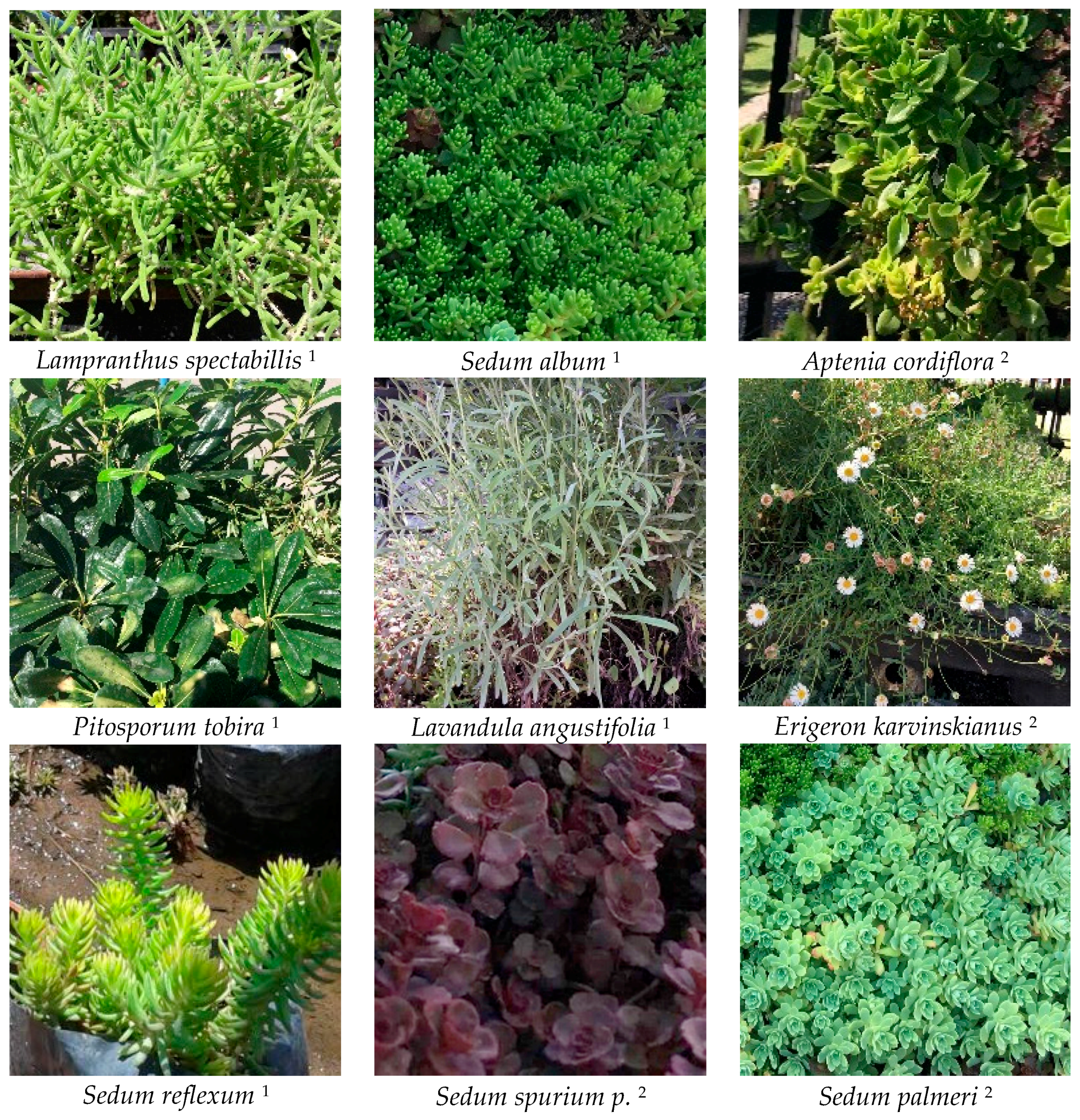
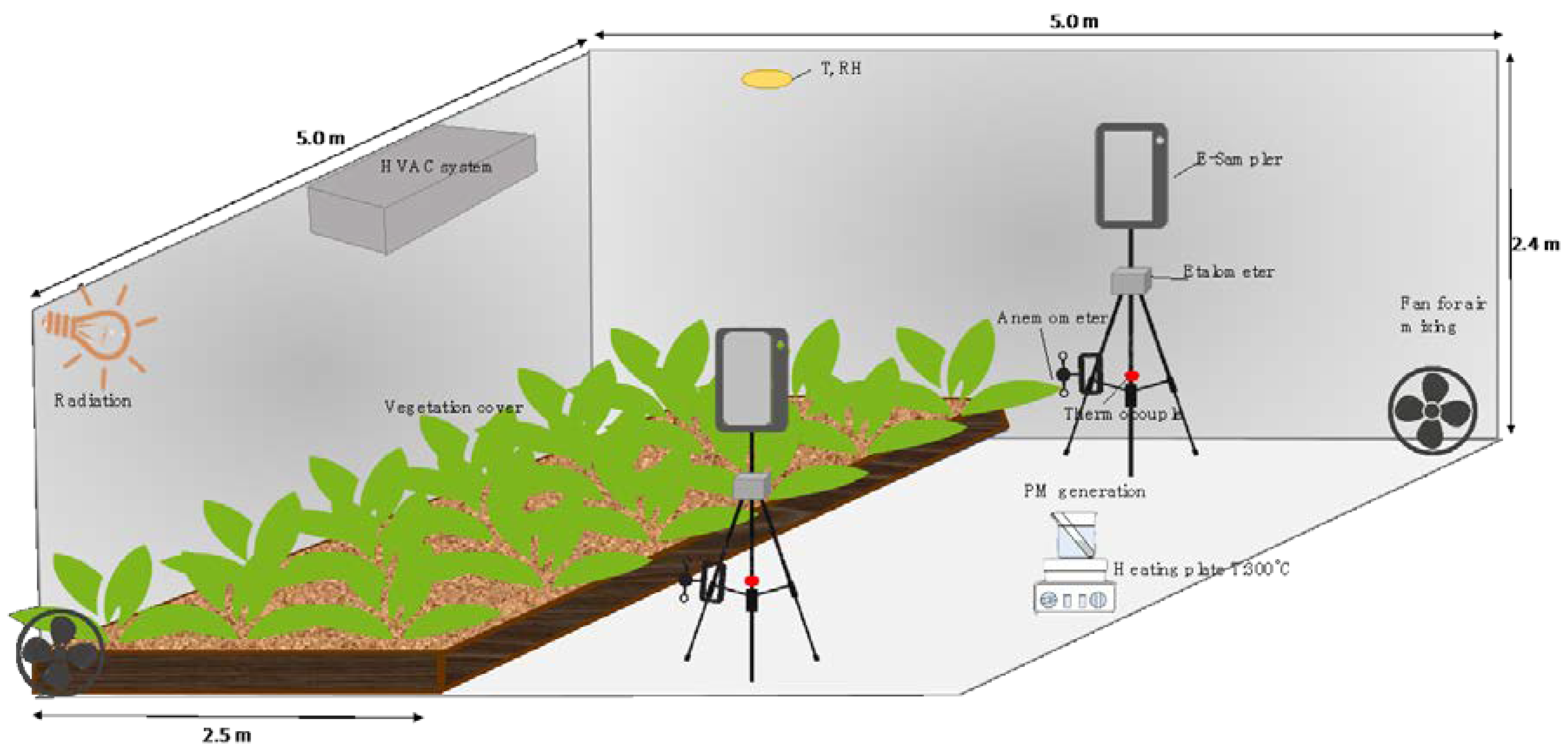
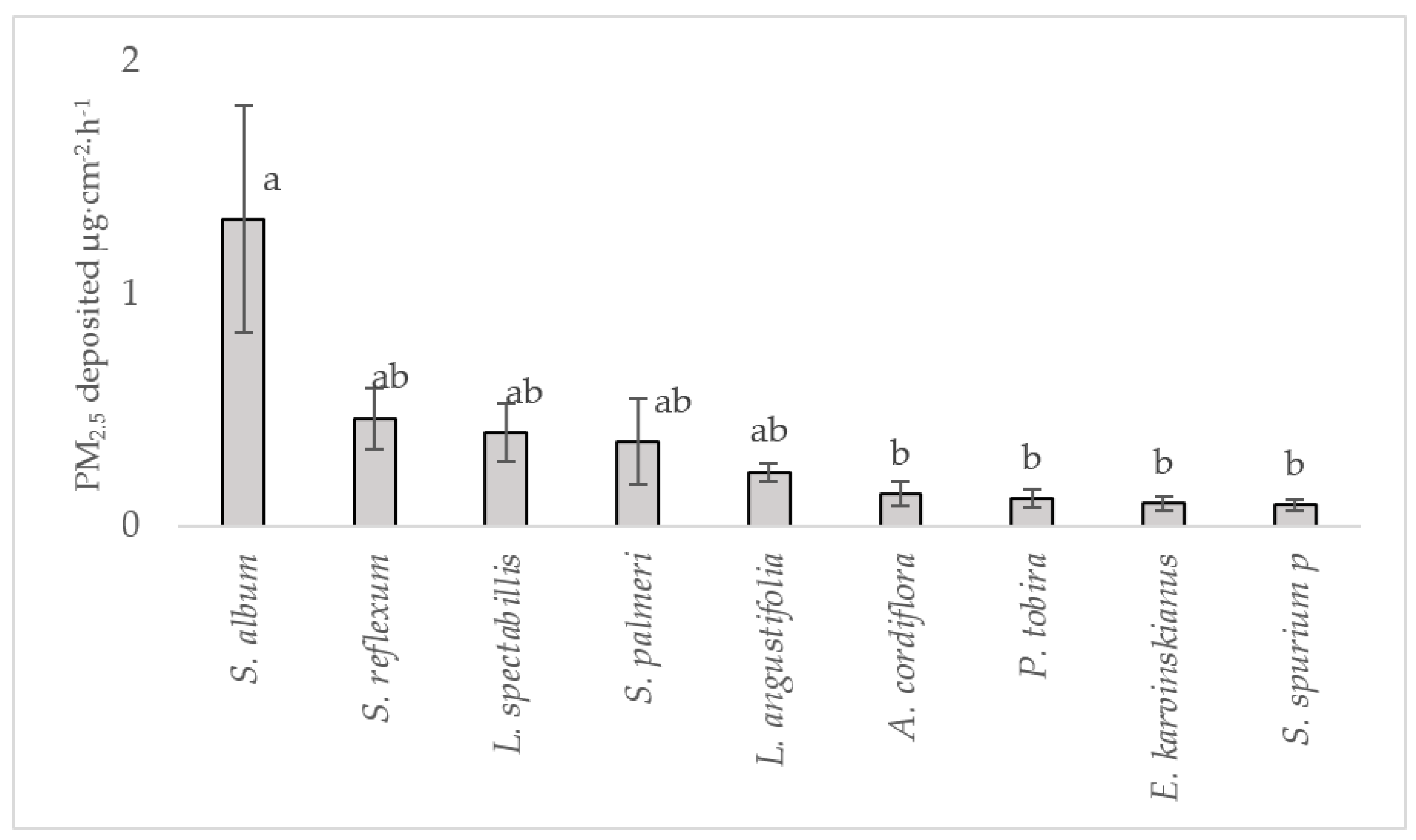
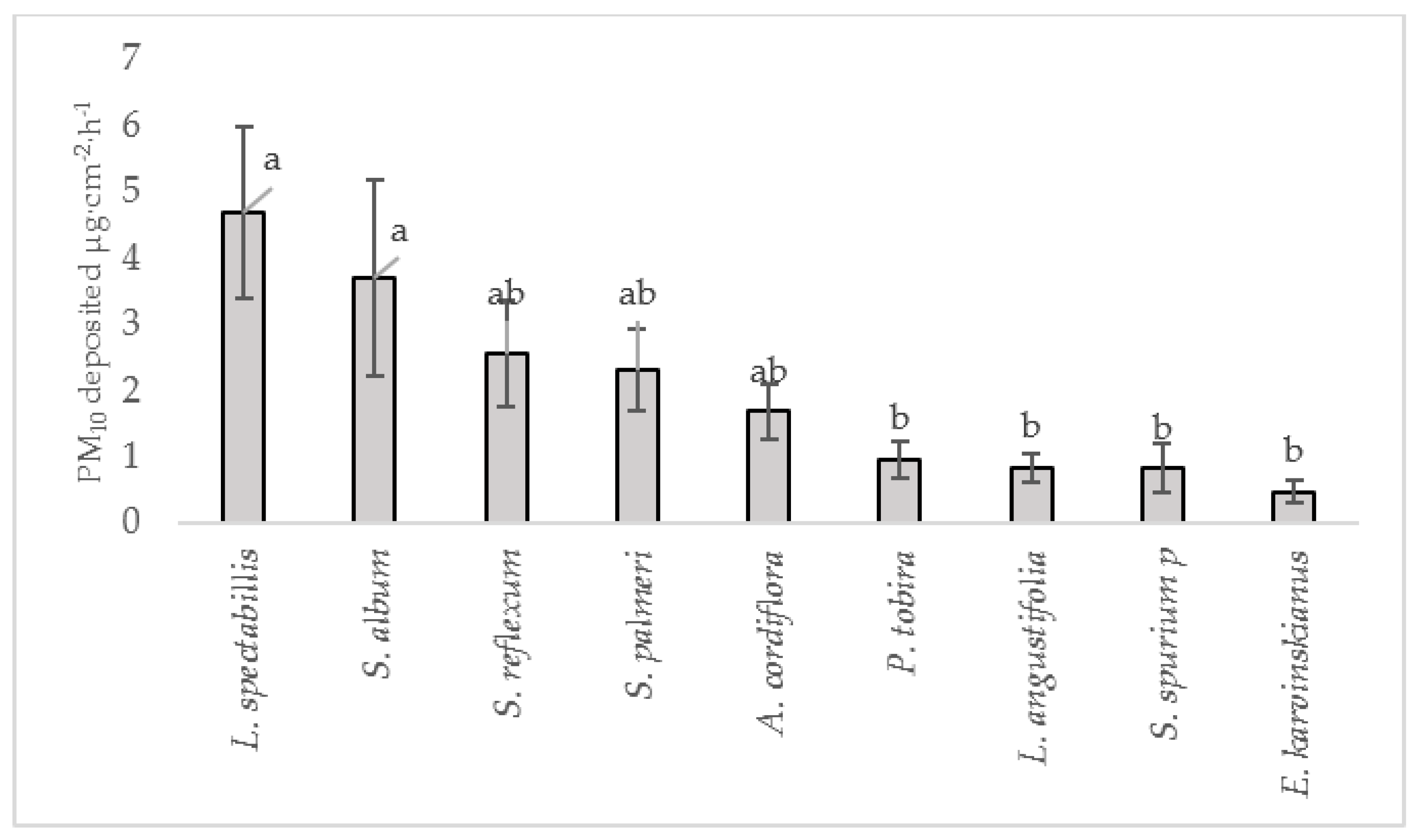

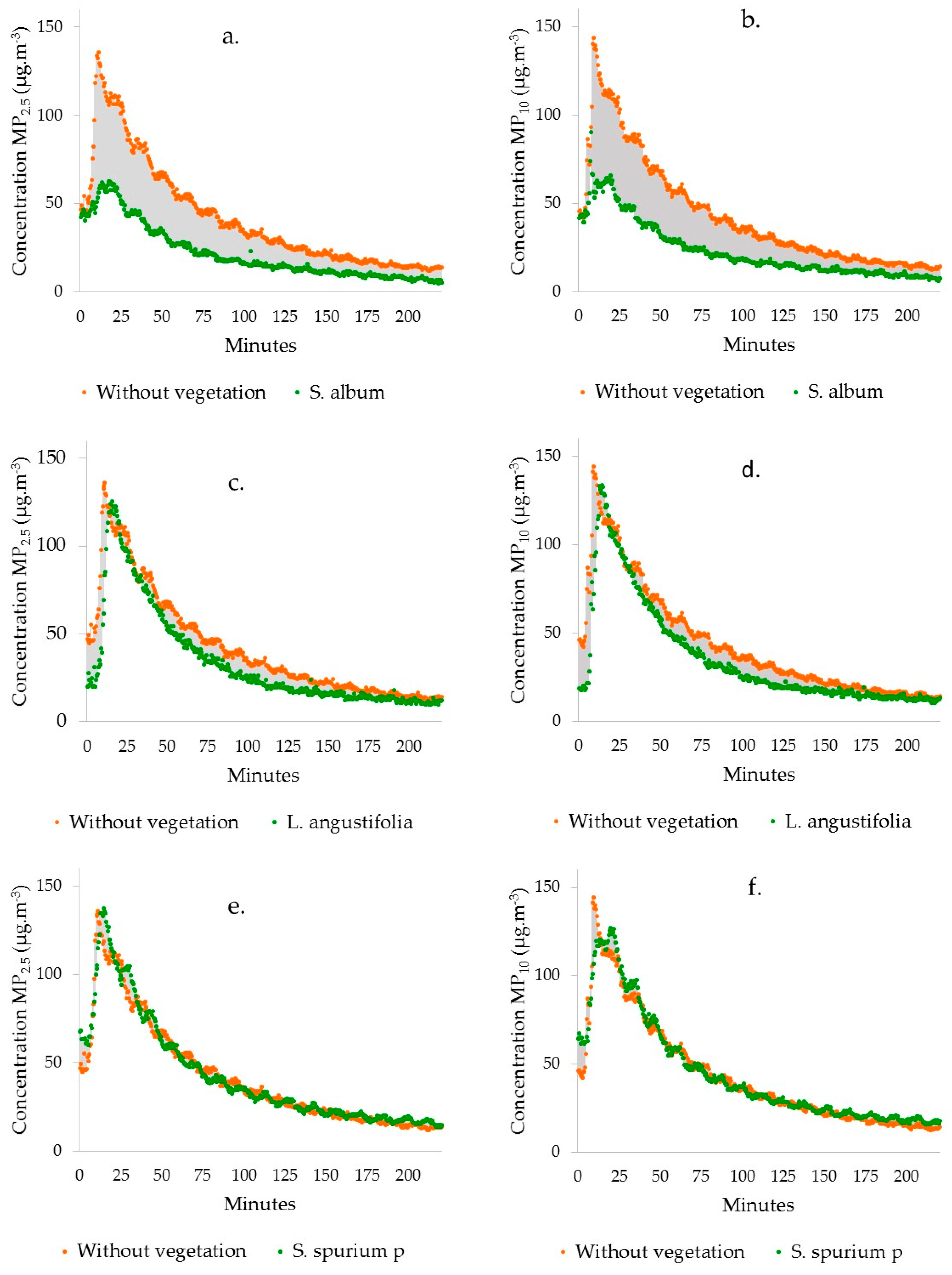
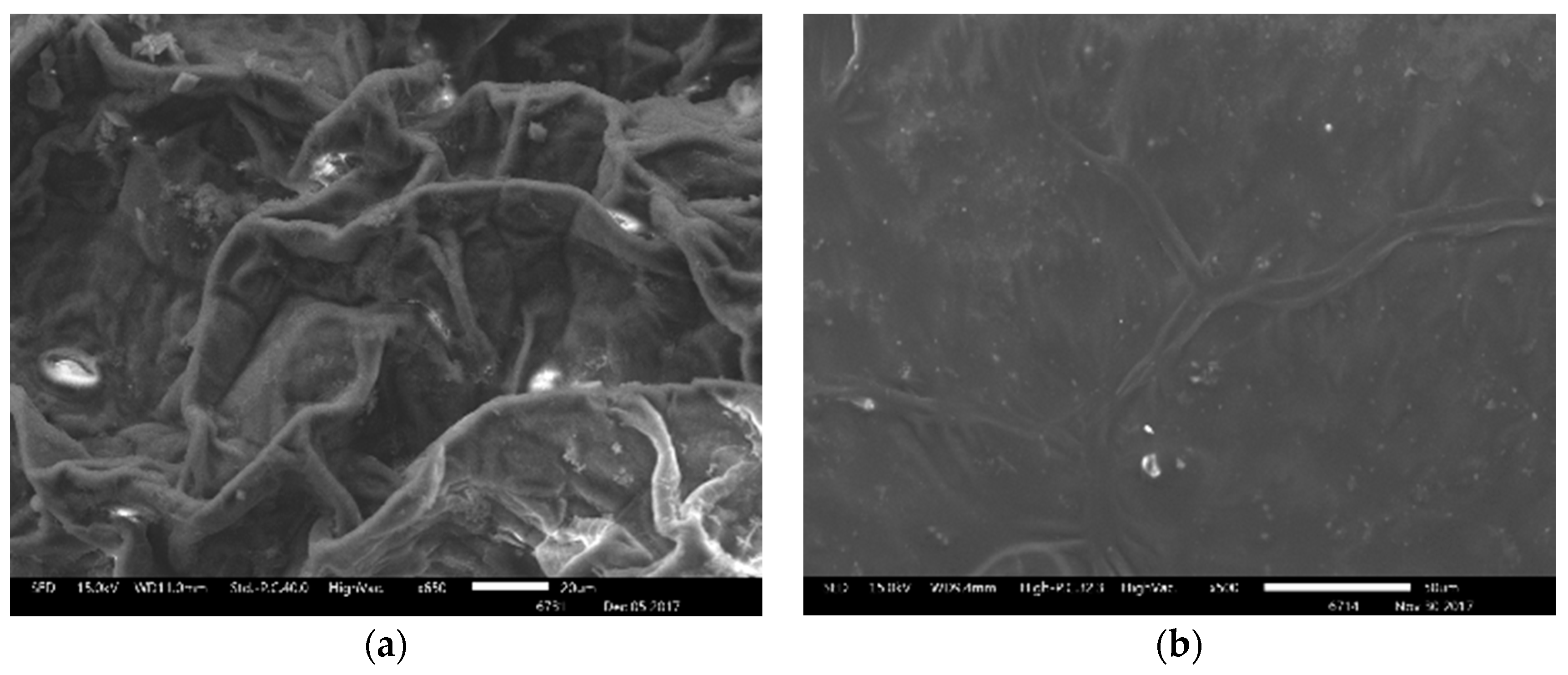
| Ref. | Type of Infrastructure | Method | Type of Vegetation | Location | Species Studied | Main Findings | Potential for Air Remediation |
|---|---|---|---|---|---|---|---|
| [12] | GR | Scanning Electron Microscopy (SEM) | Grasses and herbaceous plants | Manchester, UK | Agrostis stolonifera, Festuca rubra, Plantago lanceolata and Sedum album | Overall, GRs were not as efficient as trees. However, Festuca rubra showed a potential for air pollution mitigation closes to trees. | Dry deposition of PM10 between 0.42 g·m−2·year−1 and 1.81 g·m−2·year−1. |
| [13] | LW | PM concentration monitoring in an environmental chamber | Grasses | California, USA | Festuca festina | LW must function as air PM filters in indoor spaces | PM10 concentration is reduced between 20% and 40% |
| [15] | GR | Outdoor PM concentration monitoring | Shrubs, grasses and herbaceous plants | Singapore | Furcraea foetida ‘Mediopicta’, Aloe vera Aptenia cordifolia, Carpobrutus edulis, Delosperma lineare, Zephyranthes candida, Zephyranthes rosea, Lonicera japonica, Callisia repens, Tradescantia pallida ‘Purpurea’, Sanseveria trifasciata ‘Hahnii’, Sanseveria trifasciata ‘Golden Hahnii’, Sanseveria trifasciata ‘Laurentii‘, Liriope muscari, Kelanchoe tomentosa, Sedum acre, Sedum mexicanum, Sedum nussbaumerianum, Sedum sarmentosum, Sedum sexangulare, Ophiopogon intermedius, Aglaia odorata, Pandanus amaryllifolius, Portulaca grandiflora cultivars, Ixora coccinea and Murraya paniculata | The GR reduces the level of PM caused by traffic emissions | Up to 6% of PM10 is removed in the study area |
| [11] | Trees, GR, and LW | Gravimetric method | Trees, shrubs and climbers | Nowoursynowska, Poland | Trees: A. campestre, F. excelsior, P. hispanica and T. cordata GR: Forsythia × intermedia Zabel, Physocarpus opulifolius (L.) Maxim. and Spiraea japonica L. LW: Hedera helix L. | There are significant differences between species. Shrub and climber species were more efficient than trees | Dry deposition of total PM between 18 µg·cm−2 and 25 µg·cm−2 for two growing seasons |
| [10] | Trees and LW | Gravimetric method | Trees and climber | Warsaw, Poland | Trees: T. baccata and P. sylvestris LW: Hedera helix L. | The species studied accumulated large quantities of PM. H. helix L. was less efficient. The evergreen plants are efficient in collecting PM on their foliage. | Dry deposition of total PM between 8 µg·cm−2 and 140.6 µg·cm−2 for month |
| [14] | Indoor species | PM concentration monitoring in an environmental chamber | Shrubs | Santiago, Chile | Chamaedorea elegans, Peperomia jayde, Chlorophytum comosum ‘variegatum’ (spider plant), Dracaena deremensis Janet Craig’ compacta, Ficus benjamina, Dracaena marginata, Schefflera arboricola ‘Variegata’, Juniperus chinensis ‘San Jose’, Sansevieria trifasciata, Sophora macrocarpa ‘mayo’ and Quercus suber | Shrubs can reduce the environmental pollution of ultrafine particles in indoor environments, and some species are more effective than others. | Reduce up to 5.9% of indoor PM2.5 concentration |
| [8] | Trees, GR, and LW | Gravimetric method | Trees, shrubs and lianas | Beijing, China | Trees: 28 species: Ulmus pumila, Catalpa speciosa, Magnolia denudate, etc. GR: Syringa microphilla, Iles chinesis, Lonicera maackii and Sobaria sorbifolia, LW: Parthenoccisus tricuspidata, Campsis grandiflora and Parthenoccisus quinquefolia | There are significant differences on PM2.5 dry deposition among species. The layout of species significantly impacts the dry deposition. | Dry deposition of PM2.5 between 6 µg·cm−2·day−1 and 70 µg·cm−2·day−1 |
| [26] | LW | Scanning Electron Microscopy (SEM) | Shrubs and climber | Genoa, Iatly | Trachelospermum jasminoides, Hedera hélix, Cistus ‘Jessamy Beauty’ and Phlomis fruticosa | There are significant differences between species. Sampling season and timing have no influence on the results. | T. jasminoides collects a higher number of particles |
| [28] | LW | Biofilter an environmental chamber | Shrubs and climber | Sydney, Australia | Chlorophytum orchidastrum, Ficus lyrata, Nematanthus glabra, Nephrolepis cordifolia duffii, Nephropelis exaltata bostoniensis, Schefflera amate and Schefflera arboricola | There are significant differences between species associated principally to botanical component. | N. exaltata b. outperformed the other species by a significant margin across all PM fractions. |
| City or Country | Key Motivation |
|---|---|
| Copenhagen [29] | a, b |
| Montreal, Canada [30] | c, d |
| Toronto, Canada [30] | a, e, h |
| Vancouver, Canada [30] | a, e, g |
| Waterloo, Canada [30] | a, h |
| Chicago, USA [30] | e, h |
| New York, USA [30] | a, e |
| Portland, USA [30] | a |
| Basel-City, Switzerland | b, c |
| Münster, Germany [30] | a |
| Singapore [30] | f |
| Stuttgart, Germany [25] | h |
| Tokyo, Japan [30] | e |
| France [25] | b, c |
| Buenos Aires, Argentina [23] | b |
| Specie | PM Total Deposited (µg·cm−2·h−1) | |
|---|---|---|
| Mean | SE | |
| S. album | 29.33 | 8.74 |
| S. reflexum | 7.77 | 1.34 |
| S. palmeri | 6.93 | 0.42 |
| L. spectabillis | 6.28 | 1.16 |
| S. spurium p. | 2.93 | 0.32 |
| A. cordiflora | 2.20 | 0.44 |
| L. angustifolia | 1.98 | 0.16 |
| E. karvinskianus | 1.62 | 0.42 |
| P. tobira | 1.38 | 0.32 |
© 2018 by the authors. Licensee MDPI, Basel, Switzerland. This article is an open access article distributed under the terms and conditions of the Creative Commons Attribution (CC BY) license (http://creativecommons.org/licenses/by/4.0/).
Share and Cite
Viecco, M.; Vera, S.; Jorquera, H.; Bustamante, W.; Gironás, J.; Dobbs, C.; Leiva, E. Potential of Particle Matter Dry Deposition on Green Roofs and Living Walls Vegetation for Mitigating Urban Atmospheric Pollution in Semiarid Climates. Sustainability 2018, 10, 2431. https://doi.org/10.3390/su10072431
Viecco M, Vera S, Jorquera H, Bustamante W, Gironás J, Dobbs C, Leiva E. Potential of Particle Matter Dry Deposition on Green Roofs and Living Walls Vegetation for Mitigating Urban Atmospheric Pollution in Semiarid Climates. Sustainability. 2018; 10(7):2431. https://doi.org/10.3390/su10072431
Chicago/Turabian StyleViecco, Margareth, Sergio Vera, Héctor Jorquera, Waldo Bustamante, Jorge Gironás, Cynnamon Dobbs, and Eduardo Leiva. 2018. "Potential of Particle Matter Dry Deposition on Green Roofs and Living Walls Vegetation for Mitigating Urban Atmospheric Pollution in Semiarid Climates" Sustainability 10, no. 7: 2431. https://doi.org/10.3390/su10072431
APA StyleViecco, M., Vera, S., Jorquera, H., Bustamante, W., Gironás, J., Dobbs, C., & Leiva, E. (2018). Potential of Particle Matter Dry Deposition on Green Roofs and Living Walls Vegetation for Mitigating Urban Atmospheric Pollution in Semiarid Climates. Sustainability, 10(7), 2431. https://doi.org/10.3390/su10072431







